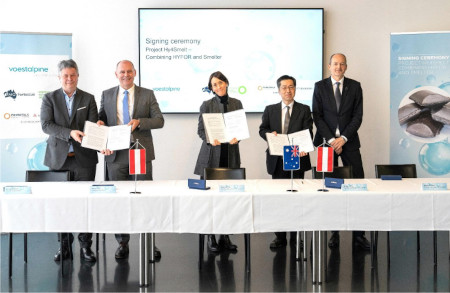- Target is to design and engineer a net-zero emission industrial-scale prototype plant for producing hydrogen-based hot metal
- Project planning phase to be finished November 2023
On December 19, Primetals Technologies, together with its strategic partners Mitsubishi Corporation, Fortescue, a global leader in the mining and heavy industries, and globally leading steel and technology group voestalpine, signed a Memorandum of Understanding (MoU).
The partnership is aimed at designing and engineering an industrial-scale prototype plant with a new process for net-zero-emission ironmaking at the voestalpine site in Linz, Austria. The collaboration will also investigate the implementation and operation of the plant. The new ironmaking process will be based on Primetals Technologies’ HYFOR and Smelter solutions.
HYFOR is the world’s first direct reduction process for iron ore fines that will not require any agglomeration steps, like sintering or pelletizing. A pilot plant has been in operation since the end of 2021, and Primetals Technologies has run numerous successful test campaigns over the last year including successful trials on Fortescue’s Pilbara iron ore products.
The new Smelter technology from Primetals Technologies is a furnace powered by electrical energy. It is used for melting and final reduction of direct reduced iron (DRI) based on lower-grade iron ores. In that way, it produces alternative green hot metal for the steelmaking plant.
Game-changing technology
“voestalpine has a clear plan to decarbonize steel production with the greentec steel program. An important first step is the incremental shift from the blast furnace route to a hybrid-electric steel pathway from 2027.Over the long term, our mission is carbon neutral steel production using green hydrogen, for which we are already undertaking intensive research into promising breakthrough technologies. With the joint project with Primetals Technologies and Fortescue, we are taking another new path towards achieving the goal of CO2-neutral steel production by 2050,” says Hubert Zajicek, Member of the Management Board of voestalpine AG and Head of the Steel Division.
Dr. Alexander Fleischanderl, Senior Vice President and Head of Green Steel at Primetals Technologies, adds: “This is a decisive step for the transition to green steel production, and we are very excited to be a key part of it. Our HYFOR technology is a result of decades of work in the direct reduction and hydrogen space. The Smelter is another game-changing green technology we are developing. By combining these solutions, we will enable a sustainable technology for green ironmaking over the long term”.
Fortescue’s main responsibility in the new project is to provide knowledge about iron ore quality and preparation. In addition, Fortescue will supply various iron ores for the new plant.
Fortescue Future Industries (FFI) CEO Mark Hutchinson said the partnership was the perfect alignment of the company’s mining and renewable energy goals: “Fortescue has more than two decades of expertise in the iron ore industry, rising to become one of the world’s lowest cost exporters, now shipping more than 180 million tons of iron ore a year. Global demand for iron ore and steel will remain strong for years to come, but we need cleaner, greener industry powered by green energy to eliminate emissions.”
An industrial prototype
The project planning phase will be used to design an industrial-scale prototype plant with a capacity of between three to five tons of green hot metal per hour. It is the first solution to link a hydrogen-based direct reduction plant for iron ore fines with a Smelter.
The main goal of the project planning phase is to develop the basis for decision to realize a prototype plant capable of continuous operation, and then to gain the know-how needed for the next step, a commercial full-scale plant. Another target is to investigate the use of various types of iron ores to produce DRI, hot briquetted iron (HBI), and hot metal and, as a next step, draw conclusions about the individual process steps as well as different combinations of them.
The hydrogen used in the new plant will mainly come from Verbund, voestalpine’s and Austria’s leading renewable energy producer, who operates a proton exchange membrane (PEM) electrolyzer named H2Future. Located in Linz, this plant has a capacity of over six megawatts, and is still the world’s largest of its kind used at a steel plant. The H2Future plant will be upgraded to allow for the compression and storage of hydrogen gas before use in the combined HYFOR and Smelter plant.


